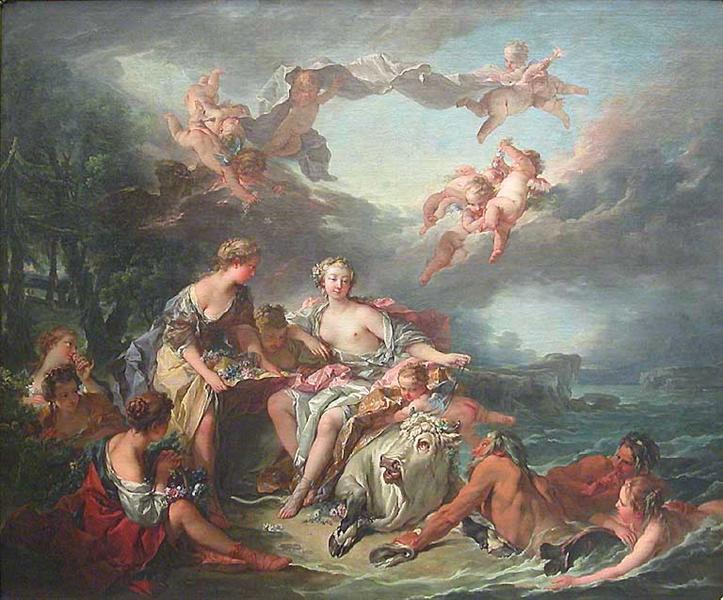描述
François Boucher's painting "The Rape of Europa", painted in 1747, is a fascinating depiction of the classical myth that captures the essence of European Rococo. In this work, Boucher delves into the narrative of Greco-Roman mythology, illustrating the moment when Zeus, transformed into a handsome bull, abducts Europa, the beautiful Phoenician princess. This theme, which mixes the mythological with the erotic, was popular in the artistic world of the 18th century and reflects the aesthetic and cultural inclinations of the time.
The composition of the work is strikingly dynamic and charged with movement. Boucher uses a diagonal arrangement that guides the viewer’s gaze through the image. Europa, who stands on the left, is depicted with an expression of surprise and wonder, while her posture is both vulnerable and seductive. Europa’s figure is the focus of attention, masterfully lit, accentuating her beauty and the vulnerability of her situation. Around her, a series of figures and landscape elements create a context that is both idyllic and disturbing. The bodies of the attendants surrounding her suggest a play of force and desire, fueling the narrative tension.
The use of color in “The Rape of Europa” is one of the most striking aspects of the work. Boucher employs a vibrant and luminous palette, characterized by soft pastel tones that merge the sky and water into an almost dreamlike horizon. The heavenly blues contrast with the golden tones of the sun and the intense, rich shadows that accompany the figures. This use of color not only sets the mood of the painting, but also highlights the shape and volume of the figures, creating a sense of three-dimensionality that is very characteristic of Boucher’s work.
The characters are depicted with meticulous attention to detail, yet always within an idealized framework. He succeeds in capturing the ephemeral nature of beauty, rendering faces and bodies with a sensuality that was typical of his style. Beneath the idyllic surface, there is an undeniable tension in the scene—the struggle between desire and autonomy, the clash of fate and choice.
This work falls within the context of the Rococo, a style that privileges decoration, charm and sensuality over gravity, and which finds its maximum expression in Boucher's work. In addition to being a prominent painter, Boucher was also an influential designer of tapestries and decorations for the French court, reflecting his ability to synthesize aesthetics and functionality. "The Rape of Europa" is not only a representation of a myth, but is also a testament to the taste of the French aristocracy of his time, who advocated works that evoked love, beauty and the sublime.
While The Rape of Europa is not as well known as the works of contemporaries such as Antoine Watteau, it delves into similar themes that explore the complexities of seduction and desire within a fantasy context. Through this painting, Boucher not only contributes to the mythological narrative, but also invites the viewer to contemplate the nature of love and loss, presenting a rich tapestry of color, form, and emotion that resonates beyond its time. It is in this crossroads between the mythic and the sensorial that the work finds its strength, becoming an essential reference point for understanding the evolution of art in the 18th century and the transition towards Neoclassicism.
KUADROS ©, a famous painting on your wall.
Hand-made oil painting reproductions, with the quality of professional artists and the distinctive seal of KUADROS ©.
Painting reproduction service with satisfaction guarantee. If you are not completely satisfied with the replica of your painting, we will refund 100% of your money.

